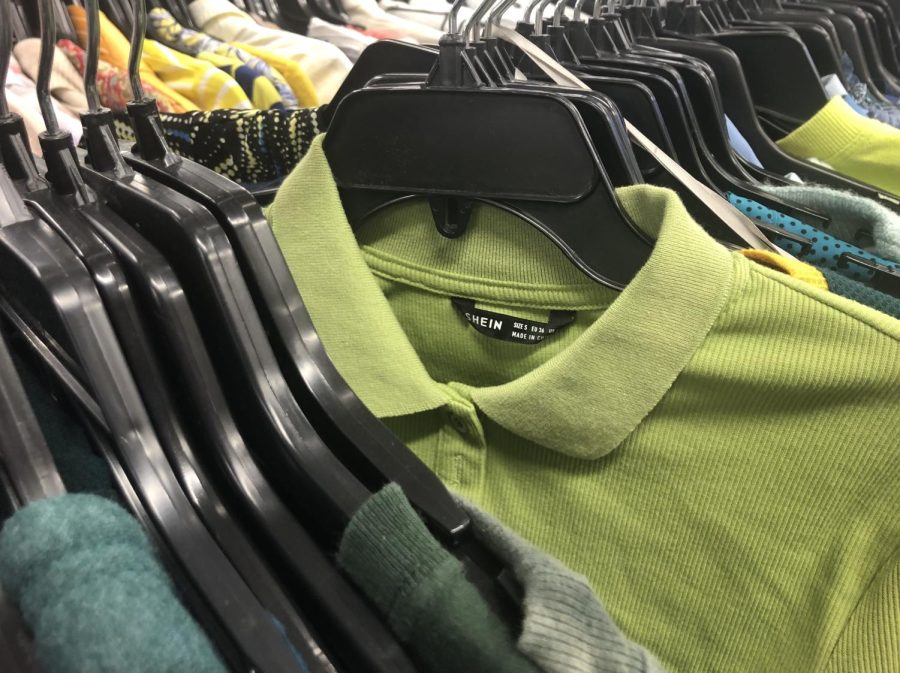Walking inside a retail store at the mall and looking at the jean section can be overwhelming. In the fitting room, one will try on different sizes and styles, yet a size eight fits too loose, and a size six is too small. The store next door has tables and racks of clothes overflowing; items are practically on the floor. At another store, girls are discussing how plaid has been trending lately, so one may decide to wear plaid the next day only to see everyone else wearing stripes instead.
Shopping for clothes can be a nightmare when issues such as sizing, overproducing and following the latest trends determine what clothes people should and should not wear. Fashion is a way that people use to express themselves through fashion, yet the fashion industry makes this difficult. These issues and more are the reasons why the fashion industry has become such a toxic environment.
Social media’s powerful influence on the fashion industry
Overstock and understock have become recurring issues because of social media. Trends tend to sell out fast depending on who is promoting them. Celebrities and influencers are the people who influence the current trends on social media platforms based on their posts. Fashion companies look at their content for ideas on what styles to produce despite many of them being styled by professionals.
Lululemon has its iconic belt bag that teenagers and their mothers have been wanting ever since it became trendy over the summer. Yet, the product has been out of stock for the longest time because everyone wants that specific belt bag. Influencers on Tik Tok and other social media apps have raved about how much they love their Lululemon belt bag which is why the product became so popular. When influencers or celebrities promote certain products or brands the expected response is for their followers to gain interest in the brand or product. This helps promote sales and is an effective way to advertise.
Yet, buying clothes and following trends can be expensive. Name-brand items tend to run a high price for their items as well which can be unappealing to customers. When it comes to trends, prices range dramatically depending on the company you buy them from. Lululemon sells their leggings and tops for over $50 each, meanwhile, Amazon has a wide selection of athletic brands for athletic wear that sells for a much more affordable price.
When it comes to shopping for clothes everyone has different opinions on the current trends. Yet, trends on social media only last for months or barely a few weeks. This creates the issue of fast fashion, which is the concept of companies mass-producing clothes in a timely way so that consumers can buy and receive the clothes as soon as possible. The quality of these items is oftentimes cheap which is why customers can afford them and buy multiple items. Yet, the items are usually not worn for a long time, especially items that go in and out of style so quickly.
The most known fast fashion brands are Shein, Forever 21, Missguided and Boohoo which also owns Nasty Gal and Pretty Little Thing. Fast fashion is the process of mass-producing clothing. The impact of overproducing clothing is that the environment experiences a massive waste of products. These companies produce so much that their products end up being thrown into landfills, or consumers donate their clothes because of the poor quality and condition their used clothes are in, despite the products being barely worn.
Fast fashion companies treat their employees unfairly
Along with these companies hurting the environment, they treat their employees poorly. Workers from countries such as Bangladesh, China and India commonly spend 14 to 16 hours a day at warehouses. These countries all share that their governments do not have much control over these fast fashion companies. As a developing country, the government has low labor standards in place.
These million-dollar companies are paying their workers the bare minimum so they can maximize profits. Their working conditions are unsafe and unsanitary. If workers try to challenge their rights, they risk losing their job and many of them need to provide for themselves or their families. People who live in poverty do not have many options or opportunities to work anywhere else. Workers are usually given a few months’ notice to produce hundreds of units of clothing. These companies need to change the way they operate their warehouses because workers are underappreciated for the work and effort they put into their job.
Fast fashion brands do not publicly display how they operate their business. These companies prey on customers by introducing new styles at a low cost to make them want to buy their products. The low price that companies charge for these items allows consumers to afford to keep buying more and more clothes. Over-consumption is an issue created by consumers themselves because they get rid of their items as easily as they buy them.
To avoid supporting fast fashion companies, thrifting is a great option that offers a wide selection of quality pieces at a low cost. Yet, the downside to thrifting is that it takes patience. While looking through the racks some items will have stains, holes and other imperfections. Thrift stores are constantly flooded with new clothes every day so there are plenty of items available.
The goal of fast fashion companies is to sell as much as possible. They produce clothes using poor materials and create styles similar to the current trend, yet, trends do not define fashion. Fashion is supposed to make you feel confident and comfortable no matter if it is in style or not. Trends are meant to be fun, not a rule guide on what to wear and what not to wear.
Sizing has expanded throughout the years making clothes more accessible for all body types
The fashion industry follows the same size guidelines. As people age, their bodies change which means that the clothes they wear will change as well. As the media becomes more accepting of the fact that people have different body types, companies have been more inclusive with their clothing selections. Size gaps are a big issue for consumers, especially those who are tall, curvy, petite and more so having brands create products for those specific body types is helpful.
Yet, exclusivity in the fashion industry remains constant. Some brands in particular have started tagging their clothes as one size making it sound like anyone can wear them. Yet, the item is made to fit an extra large. It can be argued that certain brands have a specific audience in mind when it comes to their clothes which is understandable, but there is no need to label an item as one size.
Walking inside a Pacsun store there is usually a section full of t-shirts. Some of the t-shirts are tagged as small, medium, medium/large or “one size.” The t-shirts that are tagged as one size fits all, are simply oversized baggy t-shirts that would fit an xl. The meaning behind an item being tagged as “one size” is that it avoids any judgment if a girl who typically wears a size small wants to wear a baggy t-shirt.
Labeling an item as “one size” is unnecessary because everyone has the free will to choose what size they want, no matter what product it is. The baggy style has been a recent trend that a lot of girls find comfortable. Wearing a hoodie two sizes too big feels comforting to some people. There is no rule saying you have to wear your size when it comes to clothes.
Fashion is meant to make people feel confident and comfortable
Exclusivity is something that can impact one’s self-esteem because everyone wants to feel included. Finding the right pair of jeans is not an easy task. It takes time to try on different styles, sizes and brands to find the perfect pair. Clothing should be made to be universal so that all sizes can feel included and not judged for their body shape.
The fashion industry has evolved in recent years and made significant changes when it comes to inclusivity. Jeans and other products are now available for petite, tall and curvy people so that they can find clothes that fit their body types. Brands are starting to produce plus sizes so that they are being more inclusive with their clothes. When it comes to fashion, everyone has a different opinion on what they dress themselves in. As cliche as it sounds, some people are passionate about fashion because it allows them to express themselves. Meanwhile, others will wear whatever makes them feel comfortable.
People should respect everyone’s body type because fashion is constantly changing and that is why there is no clear solution to solve the issues in the fashion industry. Companies have the power to decide what they make, sell and do based on their customers. Not everyone will agree with what one company may do compared to another company. As consumers, it is up to the individual to decide what brands to support. As long as you feel comfortable and confident in what you wear, that’s all that truly matters.


